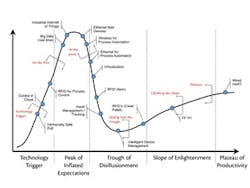Engineers are enamoured with technology, yet we often can't use the latest and coolest technology in our facilities. Most companies want to see something proven in use before installing it.
Of course, we in the press only serve to whet your appetite by providing news about the latest and greatest widget, and how it will make your life that much better and easier. This is hype to an extent, in part because most end users can't or won't share how they use the wonderful things being developed.
For those few brave souls who actually do attempt to use some of this cutting-edge technology, typically in pilot plants, they and the supplier of the technology are in the "Hope" phase of a project lifecycle in that they both hope it will work as promised or envisioned.
Also Read: Energy Harvesting Challenges For Industrial Communications Systems
Inevitably, these early implementations hit some bumps in road—some of them giant potholes—and disillusionment sets in. The latest and greatest wasn't so great after all, we decide.
Finally, we learn what the technology can really do. In the last phase of the lifecycle, assuming all worked well, we figure out how to use it and are happy with the result. It becomes mainstream, and everyone starts to use it for projects as part of their suite of tools to solve automation and control problems.
The Gartner Group develops reports on a wide range or predominantly IT-driven technologies for the consumer markets called "Hype Cycles" that describe the five phases in the adoption of a technology, and an estimate of timing before the technology reaches its expectations or dies a quiet death.
The five phases of a technology's lifecycle used by Gartner are:
- Technology Trigger—prototypes and media coverage begin;
- Peak of Inflated Expectations—lots of coverage in the press of successful implementations;
- Trough of Disillusionment—products don't live up to their hype, early adopters become discouraged, and consolidation begins;
- Slope of Enlightenment—enough experience is gained to understand how the technology might be of benefit; and
- Plateau of Productivity—it finally works.
Automation technology goes through the same cycle as other hardware and applications. Ian Verhappen's riff on Gartner's hype cycles.
My experience with new technologies and the industrial sector (Foundation fieldbus and now industrial wireless), tell me the time frame from "on the rise" to "plateau" is a minimum of 10 years. So, if you put a timeline on the curve from entry into "Peak of Inflated Expectations" or start of maximum hype to "Plateau of Productivity" or happiness, my estimate is it will take 15 years.
About the Author
Ian Verhappen
Ian Verhappen

Leaders relevant to this article:


